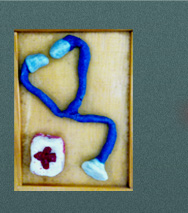|
Bedwetting and Incontinence are different issues, though both deal with involuntary passage of urine and stools.
Bedwetting, or Nocturnal Enuresis means that a child wets his bed while asleep. Usually, this is an issue since early childhood and may continue into the teens.
Incontinence implies that a child passes urine or stools, without the ability to control this movement.
|
| |
Bedwetting – Primary Nocturnal Enuresis
|
 |
Is bedwetting significant?
Many children wet the bed. According to studies, 20% of 5-year-olds wet. Every year, some children spontaneously stop wetting. By the age of 10, only 5% of children wet at night.
Bedwetting can be trying for the child and the family. It means disturbed nights, extra cleaning and laundary, the inability to spend nights with friends and family, and reluctance to go on school trips. Eventually, parents get exhausted, lose patience with their children and may censure them for this condition.
Bedwetting alone, with normal urine control and passage during the day, and never having had urinary infections, implies that bedwetting may have no other cause for concern.
|
| |
 |
Why does my child wet the bed?
The exact reason is not known. There are theories, that implicate the maturation of the bladder, the production of urine at night, and the lack of arousal, or a deep sleep pattern, as possible causes.
It is a fact, however, that bedwetting does run in families, and that in spite of your child’s best efforts, he cannot help wetting at night. It is not an issue that deserves blame or punishment.
|
| |
 |
How can bedwetting be cured?
Every year, about 8-15% of children grow out of bed wetting, without any treatment. Generally, bedwetting under the age of 5 or 6 needs no treatment.
There is no one single approach to “treating” bed wetting. It is important that you are reassured that bedwetting is not a harmful or willful act of choice that your child makes. It is often the case that you, or your spouse, or a close family member bed-wet during childhood, and that your child may carry the same genes!
Besides reassurance, and sometimes after a few basic tests, I put children through a programme. In this programme, they will be assessed to see if they are ready to take on the challenge of remaining dry at night. In many cases, just making children aware of their bodies, and bladders, and learning to pay attention to signals from their bladder can make a difference. Children are assessed to see if drugs, or a bedwetting alarm may play a role in helping them achieve their objective.
You must understand that there is no sure-shot ‘cure’ for wetting. There has to be a joint effort by a child, his family and his doctor to make things work. All this should be done in a manner that does not injure the child’s self esteem.
|
| |
 |
How long does the treatment take?
There is no fixed time schedule. Sometimes, children are dry after their first visit! At times, the programme may not impact the child immediately.
Eventually, even such children may become dry when their bodies are ready for this. By the age of 16, only 1% of children continue to wet their beds.
|
This is the cover of the booklet I hand over to children who come for the bed wetting programme. Children and their parents enjoy doing the exercises in it.
|
|
| |
| Incontinence |
| |
Incontinence implies the lack of ability to control urine or stools. Generally children with incontinence have other issues related to the brain, spine, nerves or the actual organs or muscles that control these actions.
When there is incontinence of urine and stools, there is often an issue with the spinal cord that needs tests and Xrays.
Incontinence of urine, with normal stool passage, may be due to abnormalities in the urinary tract, which will need other tests. |
| |
 |
Can incontinence be treated? We have tried many techniques.
A lot depends on the cause of incontinence. In some cases, some structural problem that is responsible can be treated surgically. In other instances, drugs can be used to achieve better control. Sometimes, even if the incontinence cannot be treated, measures to achieve “social continence” can be used. This means that your child and you can be taught how to control the removal of urine/stools from the body, to minimize passage at inconvenient places.
Please look up details of various techniques of treating incontinence in health information topics on my website. |
|
|













